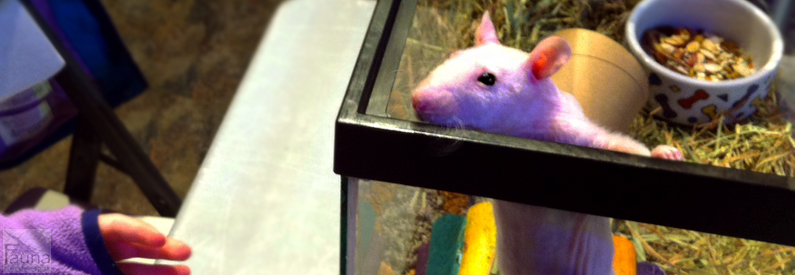
by Fauna | Dec 10, 2013 | Herpetology Club, Programs
For this month’s club meeting, we decided to briefly shift our focus from reptiles and amphibians, and expose our students to some other animals. This month we will spend time learning about Patsy, a special breed of rat known as a Cornish Rex. Often misunderstood, we wanted to teach our students how intelligent, gregarious and sensitive these animals are, and provide some insight regarding their behavior and their role as a pest species. We also learned basic rodent care by cleaning Patsy’s enclosure, preparing her meal for the day, and putting together small enrichment toys to keep her busy and happy. Being extremely intelligent, pet rats require not only the company of other rats and their human companions, but also a fair amount of environmental enrichment. This can include items to climb, boxes to nest in, and toys to chew. Portions of their food can be offered in small cardboard boxes or paper bags so that the animals have to work to find and access their food. Owning a pet rat can be a very rewarding experience, but it can also bit a bit of work. Our club members experienced what it was like to interact with rats, and found a great appreciation for these amazing animals. Jose Rodriguez is Fauna’s Eco-Education Coordinator and he runs various programming aimed at different age levels. If you are interested in any of our outreach programs such as Classroom Visits, Birthday Parties or our Herpetology Club, please contact our director of education, Jose at: jose@faunanyc.com . To learn more about Fauna NYC, visit our...
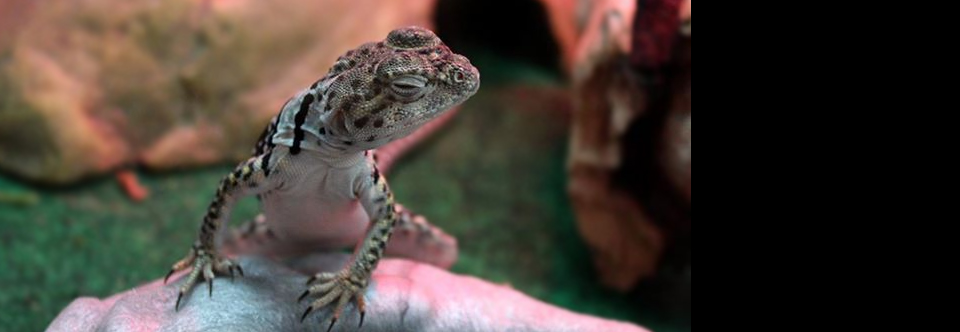
by Fauna | Nov 6, 2013 | Blog, Products, Reptiles
Here at Fauna one of the most common reptilian issues brought to our attention during these cold winter months is low humidity. Some of the signs that can be seen include decreased appetite, firm stool or constipation, inactivity, poor shedding, and may possibly include respiratory problems. Many people are unaware of how humidity actually affects their animals, especially when dealing with desert dwelling species that we associate with very dry habitats. When we look at humidity it is important to understand that generally during warm weather the humidity is higher than during the cold. According to the Mayo Clinic, the average relative humidity for someone’s home should be maintained between 30-50%. Humidity greater than 50% can cause mold, mildew and bacterial growth resulting in other health problems such as increased allergy issues. Once the humidity level drops below 30% we start to lose hydration from our bodies. This equally happens to our pets! Low humidity can cause irritation of the mucous membranes, dry itchy skin, dehydration and actually increases the risk of catching the common cold, which thrives in dry conditions. Simply breathing releases a lot of the body’s fluids. Under optimal conditions this does not result in a major loss as moist air enters our lungs. However when the humidity is below ideal conditions it can result in dehydration. We happen to manage our own hydration level by drinking more fluids or increasing the wet foods we consume without much thought, such as soups. Since most reptiles do not tend to increase the amount of fluids they are drinking during these times to maintain...
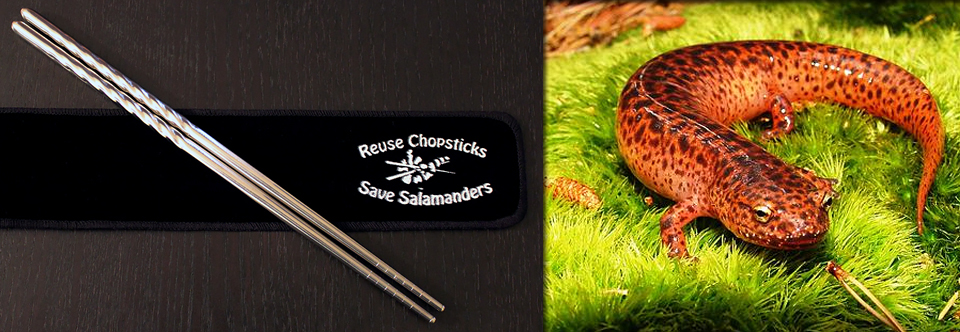
by Fauna | Nov 2, 2013 | Blog, Conservation, Products
Chopsticks for Salamanders aims to increase awareness about deforestation for the production of disposable chopsticks and educate about salamanders, and their diversity within the United States, while raising money to support salamander conservation, education, and research. The Salamander Fund Reusable Stainless Steel Chopsticks – $15 Although the primary mission of ChopsticksforSalamanders.org is the dissemination of information about the ongoing deforestation for the production of chopsticks, this project also strives to provide an alternative to disposable chopsticks. All proceeds will be used to continue this conservation effort and the remainder will be offered through a grant process for salamander conservation, education and/or research. The hope for this money is to support continued efforts to protect and preserve this continent’s salamander diversity. Purchase your reusable stainless steel chopsticks at Fauna for $15, and help save salamanders! WHY REUSE CHOPSTICKS? 3.8 million trees are felled each year to supply timber for the disposable chopsticks industry. The deforestation for the production of disposable chopsticks is an international problem and comes with the loss of critical animal habitat. Disposable chopsticks cost approximately two cents a pair for restaurants and reusable chopsticks cost around $1.17 a pair. However, reusable chopsticks have a life span of about 130 meals, making them cheaper in comparison. In 2006 to combat the massive deforestation in China the “Bring Your Own Chopsticks” movement (BYOC) was developed, helping raise public awareness and eventually galvanizing legislative action. Disposable chopsticks are an unnecessary commodity that, much like plastic bags, have an environmental friendly counterpart. WHY SAVE SALAMANDERS? Salamanders are the most abundant vertebrate in many...
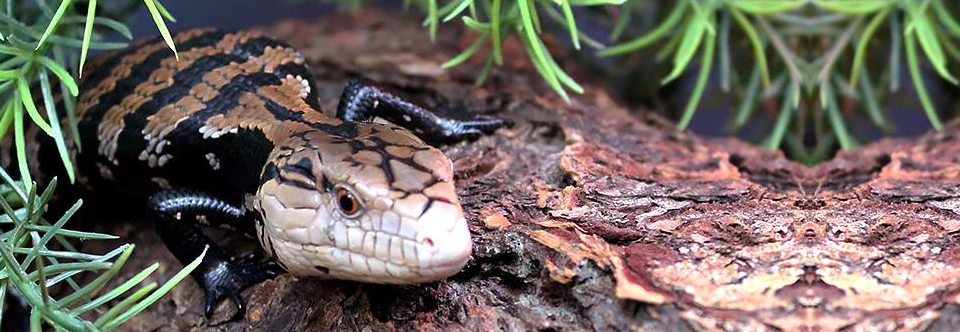
by Fauna | Oct 11, 2013 | Blog, Herpetology Club
Fauna’s Herpetology Club gathered, once again, for its second meeting of the school year. After reviewing a few things from last month’s lesson on the difference between reptiles and amphibians, we moved on to a brand new topic; the four living orders of reptiles. We learned that scientists classify reptiles according to the structure of their skulls, comparing special openings known as temporal openings. We are also able to differentiate between the various orders by way of their physical traits. Once we got a good handle on the four orders of reptiles, we moved on to the differences between reptiles and snakes, the two members of the Order Squamata. While there are differences between snakes and lizards, both are distinguished from the other orders of reptiles by way of specialized jawbones. The quadrate bones, as they are known, are very mobile allowing the upper jaw to move independently of the skull. This gives squamates the ability to ingest larger prey. However, the two are fairly distinct. Amongst the many differences, snakes lack the limbs, traditional eyelids, and ear holes that lizards possess. We utilized our resident Desert King Snake and Blue-tongued Skink to observe these differences, as well as learn proper techniques for handling a constricting snake and a large, elongate lizard. Written by Jose Rodriguez, Fauna’s Eco-Education Coordinator. Jose runs various programming aimed at different age levels. . To learn more about Fauna NYC, visit our website! Sign up for our eNewsletter for new animal arrivals, product discounts, and upcoming...
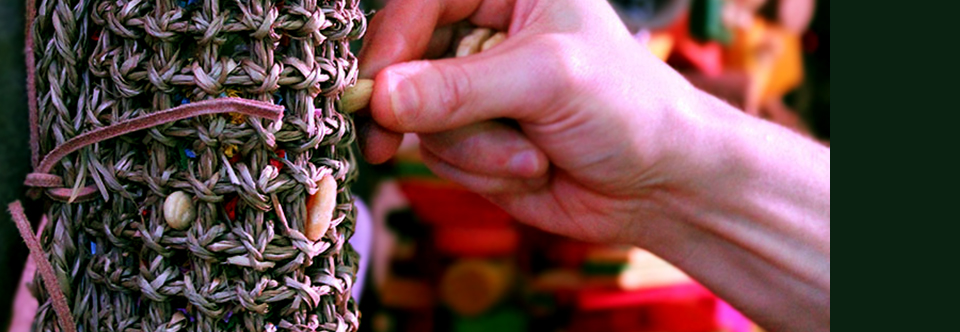
by Fauna | Oct 10, 2013 | Aviary, Blog, Products
This week we would like to spotlight one of our favorite products for birds, the California Roll. Unlike its sushi friend this one is far from fishy! This item was designed to be a fantastic toy for pet birds. We have found that it is one of the best foraging toys for birds with little effort for the lazy human! Simply by inserting dry treat items into the perfectly sized opening in the mat you can create hours of foraging opportunities for your feathered friend. While we may not like to work for our food it has been proven in scientific studies that birds do. The study showed that when offered an open dish of food that the birds in the study preferred to feed from stations where they had to forage. . . Foraging can help with behavioral issues such as screaming when you leave the room, feather picking and self mutilation among many other things. Over weight birds and birds that typically don’t play with toys can benefit from working for food as well. Give it a try and share photos of your birds using the California Roll with us! . To learn more about Fauna NYC, visit our website! Sign up for our eNewsletter for new animal arrivals, product discounts, and upcoming events....






